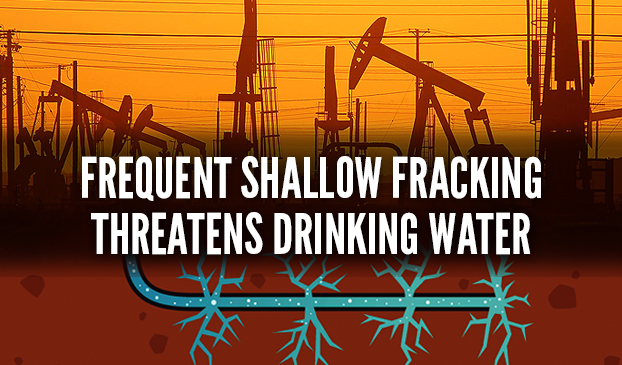
Researchers have uncovered that shallow fracking is much more common than previously thought, reviving concerns about the contamination of the nation’s drinking water.
Fracking, a technique designed to recover gas and oil from shale rock, is a controversial process. Opponents of fracking argue that the drilling process could contaminate the water table, but its supporters claim that the practice is carried out at such depths that contamination would be impossible.
However, according to a recent survey from Stanford University, shallow fracking is more widespread than previously thought. The evidence that fracking is happening at the same depth as water sources has raised concerns that it could be a threat to America’s drinking water.
The Survey and Results

Hydraulic fracturing, or “fracking,” is the process of drilling and injecting fluid into the ground at a high pressure in order to fracture shale rocks to release natural gas inside.
Via: Telegraph
Stanford University conducted the first survey on fracking in the United States, which found that the technique was used at shallow depths in 16 percent of publicly recorded sites in 27 states. Scientist Robert Jackson and his colleagues studied the depths in which the fracking procedure was carried out in relation to the water table.
Researchers used FracFocus well data from 2008-2013 and found the depths of fracking drilling is inconsistent. Some wells stretched deeper than 3 miles, while others were found to be as shallow as 100 feet.
For the fracking well to be considered shallow, it must be drilled less than a mile deep. Researchers found that 12 of 27 states had at least 50 shallow wells. Texas, Arkansas and California had the most shallow wells, at 2,872, 1,224 and 804 wells, respectively.
Supporters of the oil-gathering technique claim that the process is carried out underground at more than a mile below the surface. However, the study found that out of 44,000 wells, about 7,000 were fracked around the same depth as drinking water sources.
Environmental Concerns

Fracking is an extremely controversial process because many believe that it contaminates groundwater and leads to air quality degradation.
Via:Daily Kos
Many are worried that fracking has severe environmental costs. The process not only uses a large amount of water, but it also has the potential to contaminate water with fracking fluid or methane. The most dangerous wells are those that are shallow and use about one million gallons of water.
“Studies have shown that when these high-pressure wells fracture the bedrock, the cracks can extend as much as 2,000 feet upward. This provides an opportunity for the chemical-laced water used in fracking to migrate to the shallower depths of the water table. And the smaller the gap between drilling and surface water, the greater the chance of interaction,” according to Robert Jackson in an article from Inside Climate News.
If the fracking is carried out more than a mile underground, which is deeper than 5,000 feet, fracking’s supporters claim that it would be impossible leak into a to a shallow aquifer at around 1,000 feet. But the study reveals many previously known shallow wells, creating a heightened level of apprehension about the practice.
FracFocus is an industry-backed database where the information posted is voluntary, which means that the findings may be incorrect. The amount of shallow fracking wells could actually be much greater.
A few states where the data was likely to be inaccurate are Illinois, Indiana and Kentucky and Michigan. The fracking companies present in these states did not report data to FracFocus.
The EPA conducted an investigation where they discovered fracking-related water contamination, but concluded it wasn’t a widespread problem. This conclusion shocked researchers and environmentalists tracking the studies.
Another issue that Stanford researchers brought up is the fact that extensive safeguards for shallow fracking operations are not required by regulators, especially in states like Arkansas, California and Wyoming. However, some states have updated their fracking laws since the study was released.
The study authors urge states to require companies to monitor water near shallow drilling sites before and after, and to report the chemicals used in their fracking operations.
Frequent Shallow Fracking Threatens Drinking Water is a post from: Watchdog for the people - CitizensReport - Prescription Drug Side Effects, Faulty Medical Device, Personal Injury Lawsuits, and More
The post Frequent Shallow Fracking Threatens Drinking Water appeared first on Watchdog for the people - CitizensReport - Medical & Consumer Protection.



















